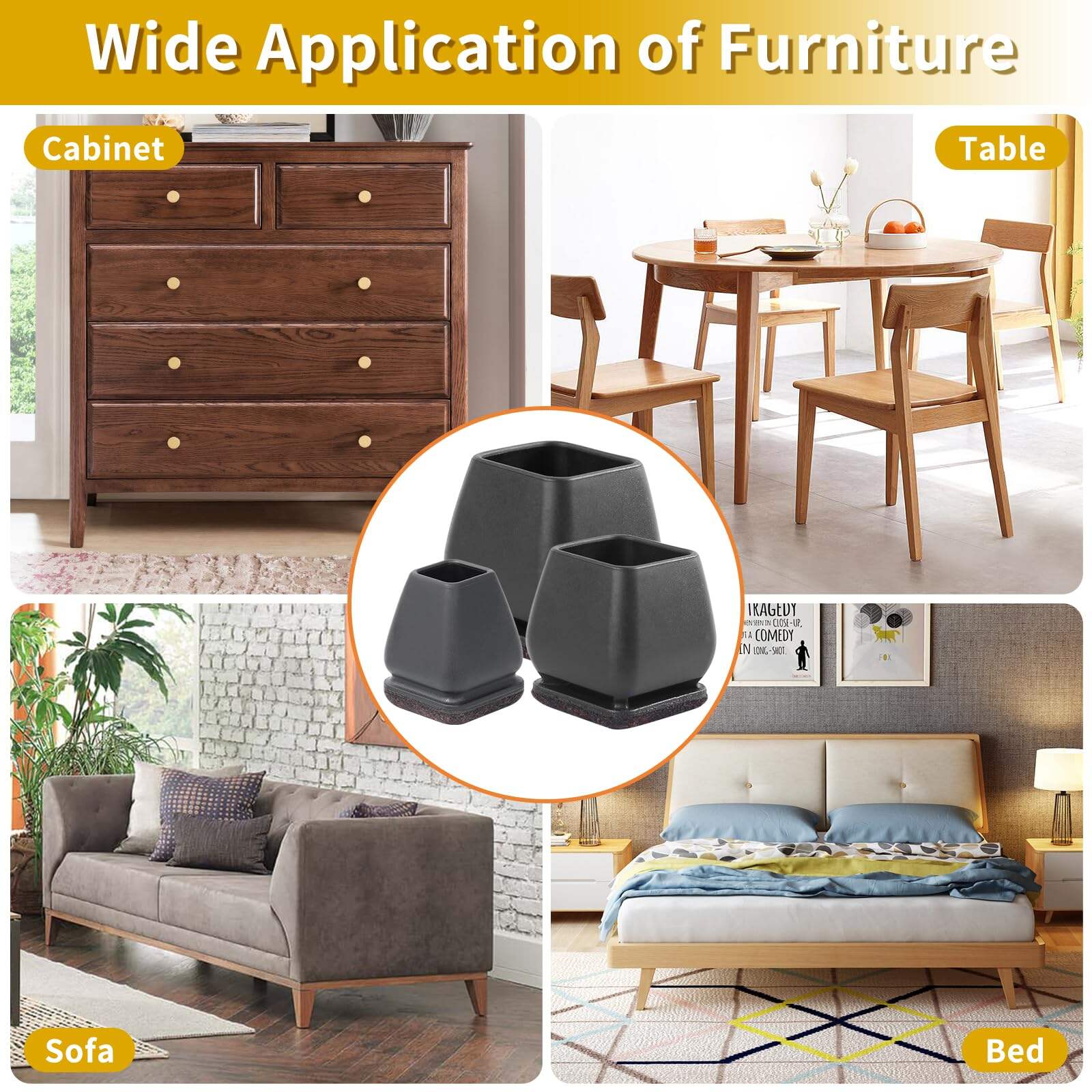How Do Chair Leg Caps Help Reduce Noise in Busy Workspaces?
In today's bustling work environments, noise pollution has become a significant concern affecting productivity, concentration, and overall workplace satisfaction. From open-plan offices to collaborative spaces, the constant scraping, dragging, and tapping of furniture creates an unwelcome symphony of distractions. Chair leg caps emerge as a simple yet highly effective solution to combat this pervasive problem, offering immediate noise reduction benefits while protecting valuable flooring investments. These unassuming accessories transform noisy workspaces into quieter, more focused environments where employees can concentrate on their tasks without the constant interruption of furniture-related sounds.
Understanding the Science Behind Noise Reduction in Workspaces
How Sound Travels Through Office Environments
Sound waves in office settings propagate through various mediums, with hard surfaces like concrete, wood, and tile floors acting as excellent conductors for vibrations. When furniture legs make direct contact with these surfaces, they create impact noise that travels through the building structure, affecting not only the immediate area but also adjacent rooms and floors below. The frequency and intensity of these sounds can range from low-frequency thuds when heavy chairs are moved to high-pitched scraping noises that pierce through ambient office noise. Understanding this acoustic phenomenon helps explain why chair leg caps are so effective at breaking the sound transmission chain.
The Physics of Vibration Dampening
Chair leg caps work on the principle of vibration isolation, creating a barrier between the hard furniture leg and the floor surface. The soft materials used in these caps, typically rubber, silicone, or felt, absorb kinetic energy that would otherwise be transmitted as sound waves through the floor structure. This energy absorption converts mechanical vibrations into heat, effectively dissipating the force that creates noise. The material properties of quality chair leg caps include high damping coefficients and optimal durometer ratings that maximize their sound-absorbing capabilities while maintaining durability under repeated stress cycles.

Types and Materials of Noise-Reducing Chair Leg Caps
Silicone-Based Protection Systems
Silicone chair leg caps represent the premium tier of noise reduction solutions, offering exceptional durability and consistent performance across varying temperature conditions. These caps maintain their flexibility and shock-absorbing properties even in environments with significant temperature fluctuations, making them ideal for offices with varying climate control systems. The non-porous nature of silicone prevents dust and debris accumulation, ensuring long-term effectiveness without regular maintenance. Advanced silicone formulations incorporate anti-slip properties that keep chairs stable while providing superior noise dampening compared to harder materials.
Felt and Fabric Solutions
Felt chair leg caps excel in environments where gentle floor protection meets noise reduction requirements, particularly effective on hardwood, laminate, and luxury vinyl surfaces. The dense fiber structure of quality felt creates multiple layers of sound absorption, while the soft texture ensures smooth, silent movement across floor surfaces. These caps often feature adhesive backing for secure attachment and come in various thicknesses to accommodate different noise reduction needs. The natural properties of felt make these caps an environmentally conscious choice for organizations prioritizing sustainable workplace solutions.
Rubber and Composite Materials
Heavy-duty rubber chair leg caps provide robust noise reduction for high-traffic environments and heavier furniture pieces, offering excellent resistance to compression set and maintaining their shape under constant load. Advanced composite materials combine the best properties of different polymers, creating caps that deliver superior noise reduction while providing enhanced durability and floor protection. These materials often incorporate specialized additives that improve their acoustic properties, making them particularly effective in challenging environments where maximum noise reduction is essential for productivity and comfort.
Installation and Compatibility Considerations
Measuring and Fitting Procedures
Proper installation of chair leg caps begins with accurate measurement of furniture leg dimensions, including both diameter and shape profiles to ensure optimal fit and performance. Square, round, and rectangular leg configurations require specific cap designs that provide full contact coverage for maximum noise reduction effectiveness. The installation process typically involves cleaning the leg surfaces, checking for any damage or irregularities, and selecting the appropriate cap size that provides a snug fit without being overly tight. Proper fitting ensures that the caps remain securely attached during normal furniture movement while maintaining their noise-reducing properties over extended periods.
Compatibility with Different Furniture Types
Office chairs, conference room seating, bar stools, and task chairs each present unique installation challenges that require careful consideration of cap selection and attachment methods. Rolling chairs with casters may benefit from additional caps on stationary legs, while fixed seating requires caps that can withstand lateral movement forces without displacement. The weight distribution characteristics of different furniture types influence cap material selection, with heavier pieces requiring more robust materials that maintain their shape and effectiveness under increased load conditions. Compatibility also extends to aesthetic considerations, with cap colors and finishes available to complement various furniture styles and office design schemes.
Workplace Productivity Benefits Beyond Noise Reduction
Enhanced Focus and Concentration
The implementation of chair leg caps creates measurable improvements in workplace concentration levels, with studies indicating significant reductions in distraction-related productivity losses when environmental noise is minimized. Employees report improved ability to engage in deep work sessions, participate more effectively in phone conferences, and maintain focus during complex tasks that require sustained attention. The psychological benefits of a quieter workspace extend beyond mere comfort, contributing to reduced stress levels and improved job satisfaction scores across diverse organizational settings. These concentration improvements translate directly into enhanced work quality and increased output capacity for knowledge workers whose performance depends heavily on mental focus.
Professional Image and Client Relations
Quiet, well-maintained office environments project professionalism and attention to detail that positively influences client perceptions and business relationships. The absence of disruptive furniture noises during meetings, presentations, and client consultations creates an atmosphere of competence and organization that supports business objectives. Chair leg caps contribute to this professional ambiance by eliminating embarrassing squeaks, scrapes, and thuds that can interrupt important discussions or distract from key presentations. The investment in these simple accessories demonstrates organizational commitment to creating optimal working conditions for both employees and visitors.
Cost-Effectiveness and Long-Term Value Analysis
Initial Investment Versus Ongoing Benefits
The modest upfront cost of chair leg caps delivers exceptional return on investment through multiple benefit streams including noise reduction, floor protection, and productivity enhancement. When compared to alternative noise control solutions such as acoustic panels, carpet installation, or office layout modifications, chair leg caps represent one of the most cost-effective interventions available to facility managers. The immediate implementation without construction disruption or significant space modifications makes these accessories particularly attractive for organizations seeking quick improvements in workplace conditions. Long-term value calculations must include avoided floor repair costs, reduced cleaning requirements, and the quantifiable productivity gains from improved workplace acoustics.
Maintenance and Replacement Considerations
Quality chair leg caps require minimal maintenance while providing years of reliable service, with replacement intervals typically measured in multiple years rather than months for premium materials. Regular inspection protocols help identify caps that may require adjustment or replacement, ensuring continued effectiveness of the noise reduction system. The ease of replacement and availability of compatible caps from reliable suppliers minimizes disruption when maintenance is required. Organizations can optimize their investment by establishing preventive maintenance schedules that address cap condition before performance degradation affects workplace noise levels or floor protection capabilities.
Environmental Impact and Sustainability Factors
Material Lifecycle and Environmental Responsibility
Modern chair leg caps increasingly incorporate recycled materials and sustainable manufacturing processes that align with corporate environmental responsibility initiatives. The longevity of quality caps reduces replacement frequency, minimizing waste generation and supporting circular economy principles in office furnishing practices. Biodegradable options made from natural rubber and organic materials provide environmentally conscious alternatives for organizations prioritizing sustainability in their procurement decisions. The reduced need for floor refinishing and replacement due to cap protection extends the lifecycle of existing flooring materials, contributing additional environmental benefits through resource conservation.
Energy and Resource Conservation
The floor protection properties of chair leg caps contribute to reduced facility maintenance requirements, lowering energy consumption associated with floor cleaning, refinishing, and replacement activities. Preserved flooring maintains better insulation properties, supporting building energy efficiency goals and reducing heating and cooling costs over time. The extended lifespan of protected floors reduces the frequency of resource-intensive replacement projects that require significant material inputs and generate substantial waste streams. These conservation benefits compound over time, making chair leg caps a valuable component of comprehensive facility sustainability strategies.
FAQ
How quickly do chair leg caps reduce noise levels in office environments
Chair leg caps provide immediate noise reduction benefits as soon as they are properly installed on furniture legs. Most users notice a significant decrease in scraping, dragging, and impact sounds within the first day of installation. The degree of noise reduction typically ranges from 60-80% depending on the cap material, floor type, and furniture weight. For optimal results, all chairs and moveable furniture in the workspace should be equipped with appropriate caps to achieve maximum noise reduction effectiveness.
What sizes and configurations are available for different chair types
Chair leg caps are manufactured in a wide range of sizes to accommodate various furniture leg dimensions, typically ranging from small diameter caps for lightweight chairs to large square or rectangular caps for heavy-duty seating. Common configurations include round caps for cylindrical legs, square caps for angular furniture legs, and specialized shapes for unique furniture designs. Most manufacturers provide sizing guides and measurement tools to help users select the correct cap dimensions for their specific furniture requirements.
Do chair leg caps work effectively on all types of flooring materials
Chair leg caps are designed to work effectively across all common flooring materials including hardwood, laminate, vinyl, tile, concrete, and carpeted surfaces. Different cap materials may be optimized for specific floor types, with felt caps particularly effective on hard surfaces and rubber caps providing excellent performance on textured or uneven floors. The noise reduction benefits are most pronounced on hard flooring materials where impact and scraping sounds are typically most problematic.
How often should chair leg caps be inspected and replaced
Regular inspection of chair leg caps should be conducted every 3-6 months depending on usage intensity and environmental conditions. Signs that caps may need replacement include visible wear, cracking, loss of flexibility, or reduced noise reduction performance. High-quality caps typically last 2-5 years in normal office environments, while caps in high-traffic areas may require more frequent replacement. Establishing a preventive maintenance schedule helps ensure consistent noise reduction performance and optimal floor protection.

 EN
EN
 AR
AR
 BG
BG
 HR
HR
 CS
CS
 DA
DA
 NL
NL
 FI
FI
 FR
FR
 DE
DE
 EL
EL
 HI
HI
 IT
IT
 JA
JA
 KO
KO
 NO
NO
 PL
PL
 PT
PT
 RO
RO
 RU
RU
 ES
ES
 SV
SV
 CA
CA
 TL
TL
 IW
IW
 ID
ID
 LT
LT
 SR
SR
 SK
SK
 SL
SL
 UK
UK
 VI
VI
 HU
HU
 TR
TR
 AF
AF
 MS
MS
 GA
GA
 LA
LA
 MN
MN



